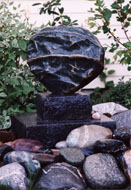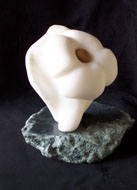Stories in Stone: Part 2 - May/June 2004
- Details
- Created: Sunday, 02 May 2004 04:11
Ed. This is the second half of David Williams’ article about types of stone used in constructing some of Seattle’s better known buildings. It is reprinted here with permission and originally appeared in Pacific Northwest, the Seattle Times Magazine, January 24, l999.
Index Granite
The other local rock used in the building trade came from a quarry near Index. John Soderburg, who helped found Swedish Hospital, opened the quarry in 1894, just two years after the Great Northern Railroad laid tracks along the Skykomish River. The quarry is now a popular rock climbing area. Index granite was used in numerous Seattle buildings including the Times Square Building and the base of Smith Tower, and for curbs and paving stones throughout the city.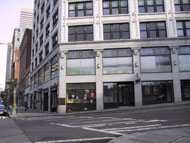
The salt-and-pepper colored rock formed 33 million years ago, as a wedge of oceanic crust on the Farallon plate, began to dive under the North American continent. As the plate slid deeper, it melted the surrounding dark, iron-rich basalt. This magma began to rise and melt the lighter, silica and aluminum-rich continental material, converting it to a granite. Continued subduction of the Farallon plate eventually produced enough heat to generate the Cascade volcanoes.
Compared with other granites, the Index is less flashy and more heterogeneous. Builders do not think that the black-and-white Index rock is as attractive as the pinks, greens, and reds found in many international granites used in Seattle. Furthermore, the variously sized blobs of black and white in the Index granite do not appeal to those who want consistency in their building stone.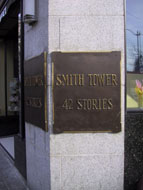
Geologists, on the other hand, like these blobs or enclaves as they call them. Enclaves provide insight into the formation of granite. For example, the white Index enclaves indicate a gas or water pocket in the magma, while the black ones are pockets of iron and manganese-rich magma that moved up through the Index granite, like the movement of colored blobs in a lava lamp.
Like many local rocks, the Index granite was popular because it was close to its market. When new rocks hit Seattle, the Index was left to the province of climbers and geologists.
Chuckanut Sandstone
Of all the local rocks, sandstone was the most commonly used for building material. Quarries in Wilkeson, Tenino, and Chuckanut Bay, as well as Waldron Island, provided the bulk of the material. These quarries, which opened as early as the 1850s, combined proximity to water or rail transport with a homogenous, well-cemented, low porosity rock.
Most of the Seattle buildings that use local sandstone center around Pioneer Square. These include the Bailey Building, Pioneer Building, Yesler Building, and Elliott Bay Bookstore. Most were built after Seattle’s legendary 1889 blaze.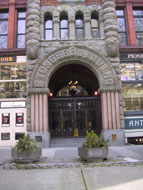
Despite the distance separating the quarries, they share a similar geologic history. All of the sandstone was deposited 40 to 50 million years ago when this region was much warmer and much flatter. The Cascades would not push their way into the picture for at least 15 million years. Low volcanic islands were forming where the Olympics now stand. Water dominated the environment with a sea to the west and rivers and swamps to the east of the land now occupied by Everett, Seattle, and Tacoma. These rivers deposited layer upon layer of sand in a vast swath of deltas, which formed at the sea/land boundary. These layers are still visible in the sandstones used as building stones.
Along with this changed topography was a changed climate. Palm trees, ferns, and magnolias flourished in the subtropical ecosystem that dominated the lowlands, while large herons and small three-toed horses traipsed through the waterways. This warm, flat period did not last long and by 25 million years ago, Washington had started to take on its modern appearance including mountains, conifers, and cooler temperatures.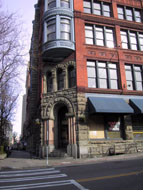
French Limestone
Many people who walk into the Westlake Center fail to notice the captivating cast of characters beneath their feet. If they took the time to look down, shoppers would find the remains of marine organisms who navigated a sea that covered Europe 175 million years ago in the Jurassic period. The tawny limestone with reddish streaks comes from quarries located about 15 miles south of Dijon, France.
Geologists refer to this rock as the Comblanchien Limestone. The fine-grained mud that comprises the unit settled in a Bahamas-like environment with shallow, lagoon-like waters protected by sandbars. The murky, mud-choked waters were inhospitable to all but a few organisms.
Sponges are the most common fossil. These bottom dwelling, filter feeders formed small mounds. Their darker color and often blobby shape stand out from the surrounding matrix. Other bottom dwellers include solitary corals, which resemble a clock face without the numbers and brachiopods, marine animals that are commonly mistaken for clams. Less common denizens were oysters, snails, and star fishes. The fine-grained quality and pureness (99-100% calcite) of the Comblanchien have made it a popular building stone since the Middle Ages. Like many stones used in the building trade, the Comblanchien’s fame spread with the railroad, which reached the quarries during the reign of Napoleon III. (The first railroad in the United States was built to reach quarries in Quincy, Massachusetts, to provide stone for Bunker Hill Monument.) The limestone has remained popular in France and is found in Orly Airport, Gare de Lyon, and the Musee d’Art Moderne in Paris.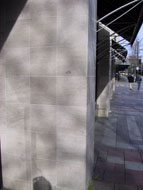
Jurassic-age French limestones play another role for some Seattlites. Many of the finest burgundy wines, such as Beaune, Nuits St. George, and Chambertin, grow on soils derived from these rocks.
The theory of plate tectonics postulates that the Earth’s surface consists of about a dozen pieces of rigid shell, known as plates. Heat from deep within the planet causes the plates to slide around the surface. The formation, destruction, and interaction of these plates, carrying the oceans and continents hundreds and sometimes thousands of miles around the surface of the planet, accounts for the features we see on the surface of Earth. Something akin to plate tectonics occurs in the building stone industry with the movement of quarried rocks hundreds and thousands of miles around the planet. Long before the globalization of the world’s economy, builders were practicing their own form of plate tectonics transporting granite, marble, and limestone around the world. Builders understood the interrelationship and interdependence of the continents long before economists coined the phrase “global economy.”

